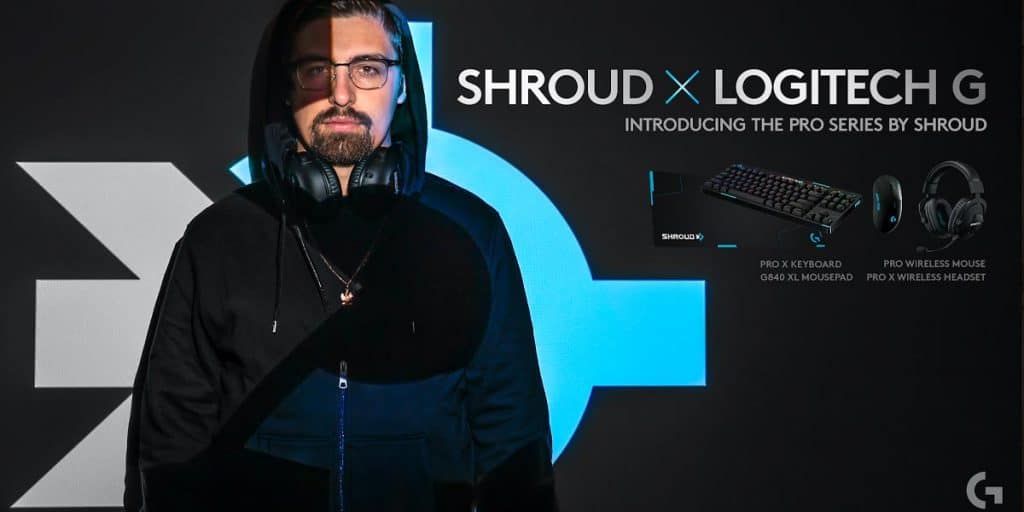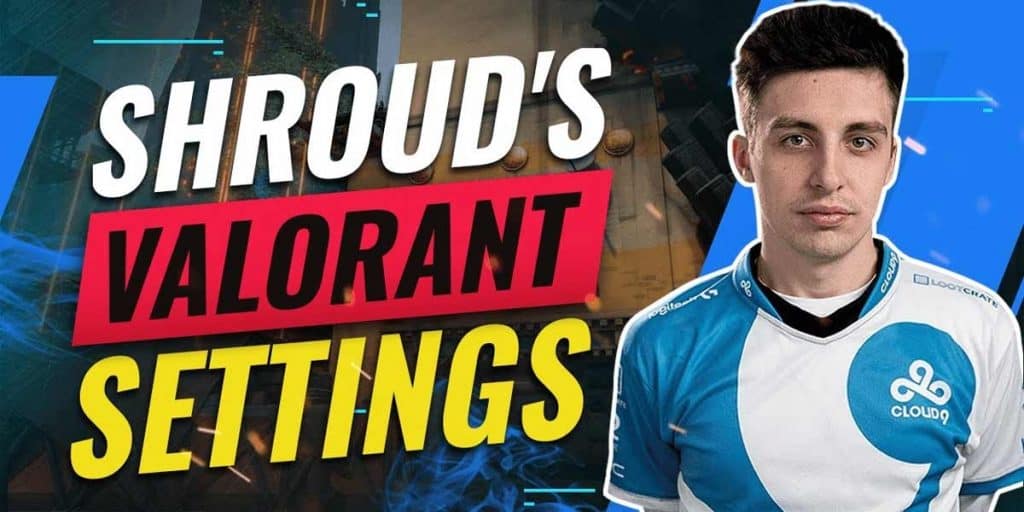Shroud Valorant Settings | What Does the Pro Use?

If you want to improve your FPS game, it helps if you have some help from the pros. When that FPS game is Valorant, Michael’ Shroud’ Grzesiek is a name that comes to mind. One of the eminent personalities of the pro-FPS gaming world, Shroud has spent much time and effort tweaking the settings to his liking.
In this article, we will take a look at Shroud’s Valorant settings, including but not limited to Shroud’s crosshair, radar, display, mouse, and keybind settings. But first, let’s know more about the man behind the fame.
Who is Shroud?

Born on 2nd June 1994, Michael ‘Shroud’ Grzesiek is a Canadian YouTuber, streamer, and former CS: GO competitive player. He has carved out his name in FPS games such as PUBG, CS: GO, Apex Legends, Valorant, Escape from Tarkov, and many more of a similar nature. Deemed as one of the best “aimers” out there, Shroud is notorious for his accuracy.
His Twitch channel has over 9.9M followers as of December 2021, making him the 5th most followed channel on the gaming platform. Boasting over 6.81M subscribers on YouTube, his fame spans far and wide. Shroud has carefully crafted his Valorant settings to match his genius, and it has been winning him games since. Before getting to Shroud’s Valorant settings, let’s take a look at his gear of choice.
Shroud’s Gear
Shroud’s Valorant Settings will hold no meaning without proper equipment to complement it. Having a convenient setup is essential to a pro FPS gamers’ success. When it comes to our Valorant champ, Shroud, here’s what he chooses:
- Monitor: Alienware AW2721D
- Keyboard: Logitech G PRO X Keyboard SE
- Arm: Rode PSA1
- Mouse: Logitech G303 Shroud Edition
- Mousepad: Logitech G840 SE
- Mic: Blue Microphones Mouse
- Webcam: Sony Alpha A6000
- Headset: Logitech G Pro X Wireless Headset SE
- Mixer: Focusrite Scarlett 2I2
- Chair: Herman Miller X Logitech Embody (Check Review)
Now that we know what Shroud uses as his gear, it’s time to move on to the most interesting part: what are Shroud’s Valorant settings? Scroll down to take a look.
Shroud Valorant Settings [Latest]

If you are starting out as a novice Valorant player or aiming towards the best, proper settings can go a long way. It can give you that extra competitive edge required to win FPS games. A look at Shroud’s Valorant settings will help you along the way. Remember, this is solely for inspiration. Valorant settings depend largely on your personal choice and comfort at the end of the day.
Having said that, take a look at Shroud’s Valorant settings:
1. Shroud Crosshair Settings
Crosshair might not seem to play an integral role in FPS games, but a good crosshair can make a world of difference to your playstyle and accuracy. If you are torn between different crosshair settings, a good place to start will be Shroud’s crosshair.
He goes for a plus-shaped white crosshair to stand out among the crowd and enhance visibility in all environments.
A white crosshair stays unobtrusive and can be locked anywhere, including onto small distant heads. This earned Shroud the “aimer” nickname. Note that the crosshair might not look the same in your settings and Shrouds. This is due to the difference in Display settings.
Here’s what Shroud’s crosshair looks like:
| Color | White |
| Center Dot | Off / 0.4 / 0.2 |
| Outlines | On / 1 / 1 |
| Outer Lines | 0.35 / 2 / 2 / 10 |
| Inner Lines | 1 / 4 / 2 / 2 |
| Movement | Off |
| Fade | Off |
| Firing Error | On (0.5x) |
Valorant offers a plethora of crosshair settings to help you customize it to the last bit. Make good use of the freedom to get the most out of your gameplay.
2. Shroud Mouse Settings
The ability to move the crosshair with precision and ease follows right after you decide on the crosshair’s choice. For this, the mouse settings make a difference. Be it the sensitivity or the DPI, everything needs to be perfect to get that winning edge.
Shroud’s mouse setting is about a low sensitivity and DPI, along with a high polling rate. His setting grants him the ability to ensure that each click and movement is registered immediately. To replicate his perfect headshots and flicks, take a look at Shroud’s mouse settings:
| eDPI | 351 |
| DPI | 450 |
| Sensitivity | 0.78 |
| Windows Sensitivity | 6 |
| Scoped Sensitivity | 1 |
Shroud has won many matches with this perfect mouse setting. In fact, many of the pros in the Valorant community like to stick to low sensitivity and DPI combo. Check it out once to see if it suits your style.
3. Shroud Keybind Settings
Now that we know Shroud’s Valorant crosshair and mouse settings, it is time to move on to the next important setting: his keybind setting. What keys and buttons are used for which command? Shroud’s keybind settings are crafted with precise and quick movements in mind. He has worked on the setting individually to ensure a natural feel to the movement and execution.
With a convenient keybind setting, quite like Shroud’s, you can switch promptly between weapons and employ a diverse range of hero abilities. This comes in handy, especially when FPS games are concerned. Here’s what Shroud considers a perfect keybind setting:
| Walk | Left Shift |
| Jump | Space |
| Crouch | Left Ctrl |
| Ultimate | X |
| Ability 1 | E |
| Ability 2 | Q |
| Ability 3 | C |
| Equip Primary Weapon | 1 |
| Use Object | F |
| Equip Melee | 3 |
| Equip Secondary Weapon | 2 |
| Interact with Spike | 4 |
This works well for him, but the settings heavily depend on your mouse and the buttons allotted for free use. Tweak the keybind settings as per your gear specifications, and you should be good to go!
4. Shroud Display Settings
Now onto yet another important component of gameplay: your display settings. To ensure that you win matches, you should be able to see the field of view clearly. To strike your enemies with the perfect aim, you need to be able to see the target well.
You need to have a sufficient balanced framerate. A setting like Shroud’s helps get rid of clutter from the screen and, in turn, facilitates singling out enemies. With a little lowered graphics, you can reduce input lag and let your system display more frames.
Shroud goes for a 1440p resolution to increase visual clarity and help single out targets at a distance. He likes to keep the game at a smooth 240 FPS to minimize latency and maximize fluidity. For this, he turns his display settings to low. Here’s what the complete setting looks like:
| Display Mode | Fullscreen |
| Material Quality | High |
| Frame Rate Limit | 240 FPS |
| Resolution | 2560×1440 |
| Detail Quality | Low |
| Texture Quality | High |
| Vignette | Off |
| UI Quality | Low |
| Anti-Aliasing | None |
| VSync | Off |
| Improve Clarity | Off |
| Anisotropic Filtering | 4x |
| Bloom | Off |
| Distortion | Off |
| First Person Shadows | Off |
With these settings, Shroud has won many matches to date. Make sure you adjust the settings as per your system specifications to get the most out of them.
5. Shroud Radar Settings
If you are at a crossroads about which minimap or radar to go for, Shroud’s Valorant settings, especially his radar settings, will be of much help. A minimap is an essential tool that requires customization. Make sure the radar is easily visible and lets you track your surroundings well. It shouldn’t hinder your in-game vision.
Here’s what Shroud’s radar settings look like:
| Rotate | On |
| Keep Player Centered | Off |
| Fixed Orientation | Based on Side |
| Minimap Zoom | 1 |
| Minimap Size | 1.028 |
| Show Map Region Names | Always |
| Minimap Vision Cones | On |
With that, we come to the end of the list. Take inspiration from these radar settings, but do not imitate them word to word. See what fits your needs, and proceed accordingly.
Conclusion
That’s all about Shroud’s Valorant settings. Go through it, explore the gear, try out the various settings, and see for yourself what helps and what doesn’t quite work for you. Once again, a pro like Shroud has undergone years of practice to reach the level of triumph as he currently holds, so do not be hard on yourself if these exact settings do not make you a winner right away. Having said that, taking a little inspiration to amp up your game never hurts. Good luck!






